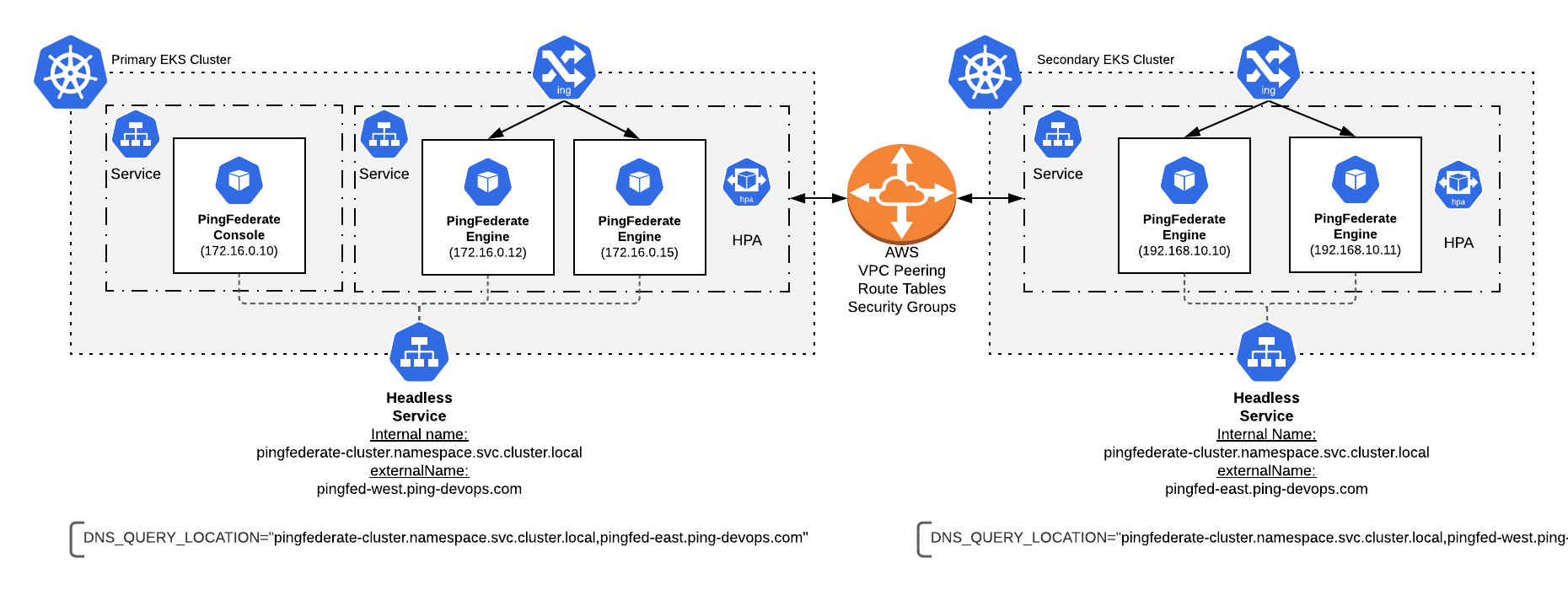Deploy PingFederate Across Multiple Kubernetes Clusters ¶
This section will discuss deploying a single PingFederate cluster that spans across multiple Kubernetes clusters.
Deploying PingFederate in multiple regions should not imply that spanning a single PingFederate cluster across multiple Kubernetes clusters is necessary or optimal. This scenario makes sense when you have:
- Traffic that can cross between regions at any time. For example, west and east and users may be routed to either location.
- Configuration that needs to be the same in multiple regions and there is no reliable automation to ensure this is the case
If all configuration changes are delivered via a pipeline, and traffic will not cross regions, having separate PingFederate clusters can work.
Note
The set of pre-requisites required for AWS Kubernetes multi-clustering to be successful is found here.
Static engine lists, which may be used to extend traditional, on-premise PingFederate clusters is out of scope in this document.
Prerequisites ¶
- Two Kubernetes clusters created with the following requirements:
- VPC IPs selected from RFC1918 CIDR blocks
- The two cluster VPCs peered together
- All appropriate routing tables modified in both clusters to send cross cluster traffic to the VPC peer connection
- Security groups on both clusters to allow traffic for ports 7600 and 7700 in both directions
- Verification that a pod in one cluster can connect to a pod in the second cluster on ports 7600 and 7700 (directly to the back-end IP assigned to the pod, not through an exposed service)
- externalDNS enabled
See example "AWS configuration" instructions here
- Helm client installed
Overview ¶

The PingFederate Docker image default instance/server/default/conf/tcp.xml file points to DNS_PING. After you have two peered Kubernetes clusters, spanning a PingFederate cluster across the two becomes easy. A single PingFederate cluster uses DNS_PING to query a local headless service. In this example we use externalDNS to give an externalName to the headless service. The externalDNS feature from the Kubernetes special interest group (SIG) creates a corresponding record on AWS Route53 and constantly updates it with container IP addresses of the backend PF engines.
External DNS
If you are unable to use externalDNS, another way to expose the headless service across clusters is needed. HAProxy may be a viable option to explore and is beyond the scope of this document.
What You Will Do ¶
- Clone the example files from the
getting-startedRepository - Edit the externalName of the pingfederate-cluster service and the DNS_QUERY_LOCATION variable as needed
Search the files for
# CHANGEMEcomments to find where these changes need to be made. - Deploy the clusters
- Cleanup
Example deployment ¶
Clone this getting-started repository to get the Helm values yaml for the exercise. The files are located under the folder 30-helm/multi-region/pingfederate.
After cloning:
-
Update the first uncommented line under any
## CHANGEMEcomment in the files. The changes will indicate the Kubernetes namespace and the externalName of the pingfederate-cluster service. -
Deploy the first cluster (the example here uses kubectx to set the kubectl context))
kubectx west helm upgrade --install example pingidentity/ping-devops -f base.yaml -f 01-layer-west.yaml -
Deploy the second cluster
kubectx east helm upgrade --install example pingidentity/ping-devops -f base.yaml -f 01-layer-east.yaml -
Switch back to the first cluster, and simulate a regional failure by removing the PingFederate cluster entirely:
kubectx west helm uninstall example -
Switch back to the second cluster and switch failover to active
kubectx east helm upgrade --install example pingidentity/ping-devops -f base.yaml -f 02-layer-east.yaml
Cleanup ¶
kubectx east
helm uninstall example
kubectx west
helm uninstall example